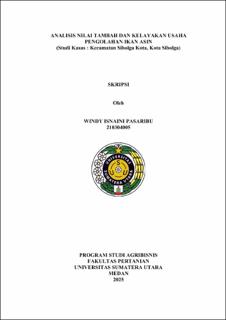| dc.description.abstract | Windy Isnaini Pasaribu. Analysis of Added Value and Feasibility of Salted Fish
Processing Business (Case Study: Sibolga Kota District, Sibolga City). (Under the
guidance of Dr. Ir. Rahmanta M.Si as Supervisor and Prof. Dr. Ir. Tavi
Supriana, MS as Examiner).
Fish is a fishery product that does not last long, so it requires processing
and preservation processes. This study aims to analyze the added value of
processing each type of salted fish and also the feasibility of the salted fish
processing business in Sibolga City District, as well as to compare the added value
and feasibility of various types of salted fish. The research location was determined
intentionally with 6 respondents of salted fish processing entrepreneurs who were
determined using the saturation method. The data analysis method used was by
calculating the added value of Hayami and calculating the feasibility with the R/C
ratio. The results of the study showed that the added value of each type of salted
fish type snapper was 28.42%, salted Baledang was 38.75%, salted Layang was
13.39% and salted Kurisi was 56.57%. The feasibility of the salted fish processing
business, the R/C Ratio of the total business was 5.78 with an average of 1.45. It is
known that the amount of R/C> 1 indicates that the salted fish business being run
is profitable, feasible to be developed. Comparison of added value and feasibility,
the salted type of curry is the most promising to be cultivated, both in terms of the
highest added value (56.57%) and the highest business feasibility (1.86). While the
layang type (13.39%) is the lowest, but the R/C Ratio or feasibility according to the
criteria is still feasible, but the profit margin is relatively small, it needs a strategy
to increase value or cost efficiency to increase the profit margin. | en_US |


